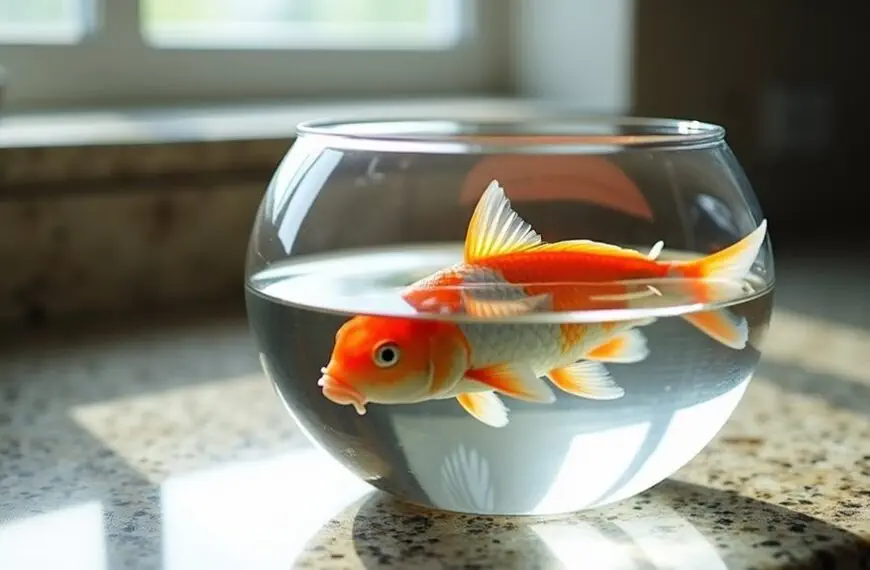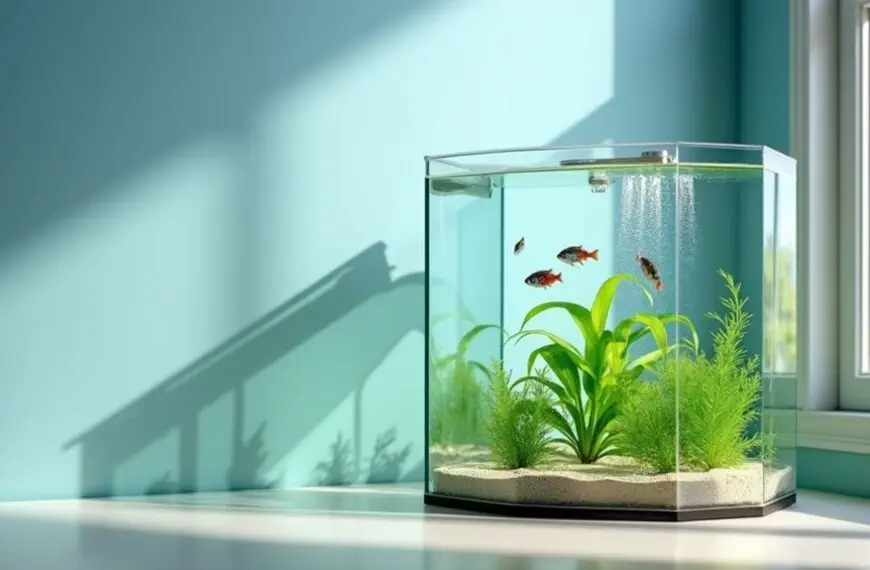You can place your fish in a temporary bowl while cleaning their tank, but you'll need to take some important steps to keep them safe and stress-free. Start by filling a clean container with water from their original tank, making sure it's large enough (at least 2-3 gallons) for comfortable swimming. Add a water conditioner to neutralize harmful chemicals, and maintain the same temperature as their tank (76°-80°F). Don't keep them in the temporary container for more than 1-2 hours, and watch for signs of distress. While this quick solution works, there are several techniques to make the process even smoother for your finned friends.
Contents
- 1 Safe Fish Transfer Methods
- 2 Preparing Your Temporary Container
- 3 Water Quality Guidelines
- 4 Duration and Timing
- 5 Preventing Fish Stress
- 6 Temperature and Environment Control
- 7 Common Mistakes to Avoid
- 8 Alternative Tank Cleaning Strategies
- 9 Frequently Asked Questions
- 9.1 Can I Use a Plastic Storage Container Instead of a Bowl?
- 9.2 How Many Fish Can I Safely Put in One Temporary Container?
- 9.3 Should I Feed My Fish While They're in the Temporary Container?
- 9.4 Can I Reuse the Same Temporary Container for Future Tank Cleanings?
- 9.5 What Signs Indicate My Fish Isn't Tolerating the Temporary Container Well?
- 10 Final Thoughts
Safe Fish Transfer Methods
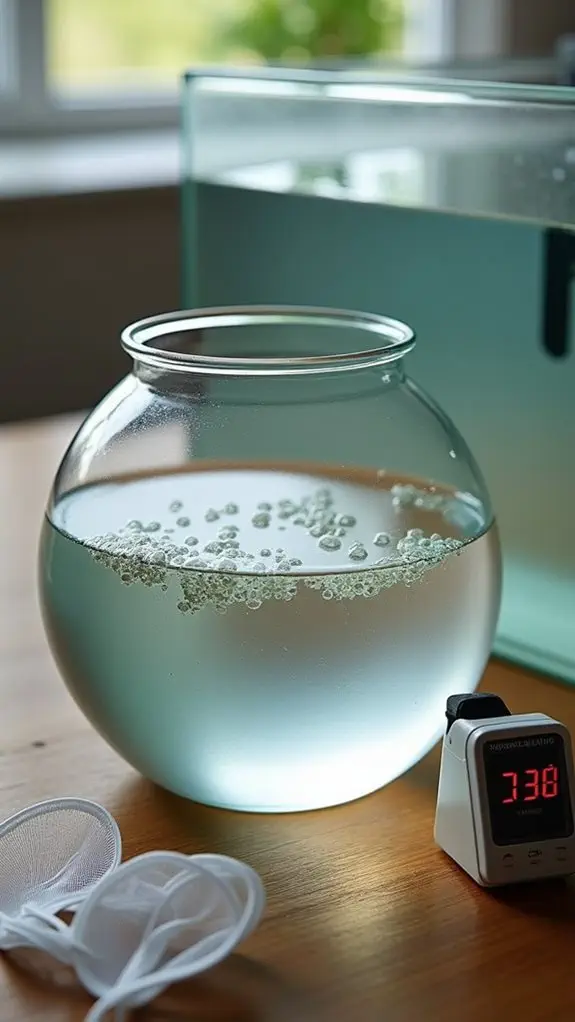
Two reliable methods guarantee safe fish transfer during tank cleaning: the floating bag method and the drip method. While both fish handling techniques are effective, each offers distinct advantages based on your situation and time constraints. Make sure to add water conditioner before starting either transfer method.
The floating bag method is quicker, requiring just 15-60 minutes as you let the sealed bag float on the tank's surface to match temperatures. If you're short on time, this might be your go-to choice. Always ensure your temporary fish tank has a secure lid to prevent escapes. A stable environment during transfers supports the health and well-being of your fish, as it reflects the importance of monitoring water parameters for long-term success.
For more thorough acclimation techniques, you'll want to take into account the drip method. Though it takes longer (30 minutes to 2 hours), it's gentler on your finned friends as it gradually introduces them to new water conditions. You'll need to slowly add tank water to their temporary container, which helps prevent any shocking changes that could stress them out.
Whichever method you choose, remember to watch your fish's behavior during the transfer. Instead of using a net, which can damage fins and scales, try coaxing them into a cup – they'll thank you for being gentle!
Keep their temporary housing time under 30 minutes to guarantee they've enough oxygen, and you'll have happy, healthy fish when they return to their cleaned tank.
Preparing Your Temporary Container
Setting up a proper temporary home for your fish starts with choosing the right container. You'll want to select a container that's at least 2-3 gallons in size and has been thoroughly rinsed with distilled water.
Remember, your finned friends need enough space to swim comfortably while you're working on their permanent home. Using a water conditioner or dechlorinator is essential if you need to add fresh tap water to the temporary container.
When it comes to container selection, avoid anything that's previously held chemicals or cleaning products – your fish won't appreciate those unwanted extras! Make sure to rinse the container multiple times to remove any soap residue that could harm your aquatic pals. Small, clean containers help minimize stress during the relocation process.
For aeration techniques, you can use water from the original tank to help maintain familiar conditions and reduce stress on your fish.
Once you've got your container ready, place it in a stable spot away from direct sunlight and heating vents. Don't forget to cover the top – fish can be surprisingly good jumpers when they're feeling adventurous!
If you're planning to keep them in the temporary home for more than a few minutes, consider adding an air stone to maintain proper oxygen levels. Your fish will thank you for creating a safe and comfortable temporary retreat.
Water Quality Guidelines
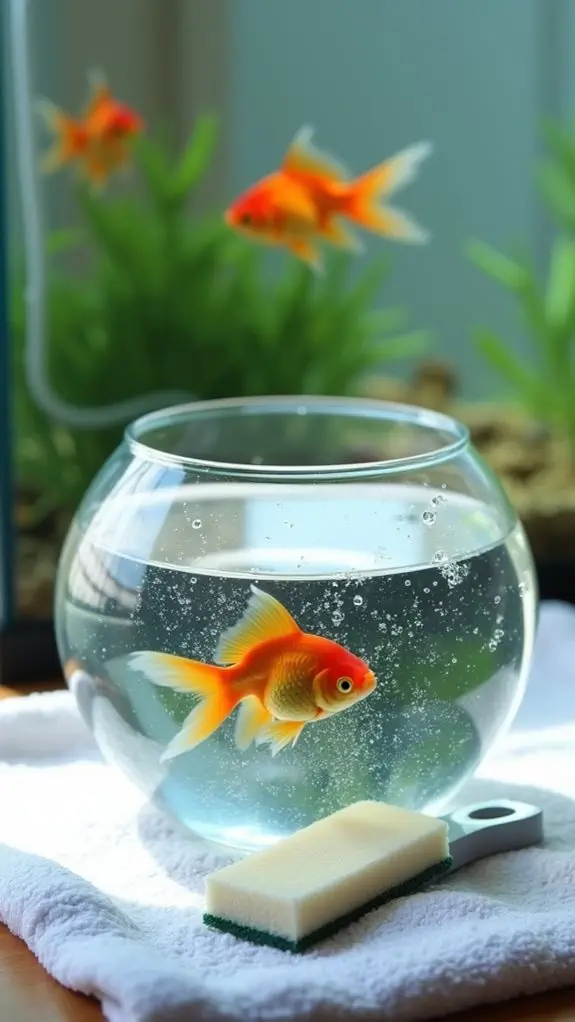
Maintaining proper water quality in your temporary container is essential for your fish's well-being. Even during short stays, your fish need clean, safe water that matches their usual tank conditions.
When transferring fish, use a clean container to prevent contamination of their temporary housing.
You'll want to use a water conditioner to neutralize harmful chemicals like chlorine, which can stress or harm your aquatic friends.
While your fish are in their temporary home, keep a close eye on the water parameters. Regular ammonia testing is important, as ammonia can build up quickly in smaller containers. Aim to maintain zero ppm ammonia to ensure your fish stay healthy.
If you're housing freshwater fish, aim to keep the pH between 6.5 and 9.0, though specific species may need different ranges. For saltwater friends, maintain a pH of 8.1 to 8.4 – they're a bit pickier about their environment!
Remember to avoid overfeeding while your fish are in their temporary container. Those uneaten flakes might look harmless, but they can quickly pollute the water.
If you'll be keeping your fish in the temporary container for more than an hour, consider adding some live plants – they're like nature's water purifiers, helping to maintain better water quality while your fishy friends wait for their clean home.
Duration and Timing
When you're moving your fish to a temporary container, you'll want to keep them there for no more than 30 minutes, whether you're doing a quick maintenance clean or a deep tank overhaul.
For routine cleanings, it's best to work efficiently and return your finned friends to their home as quickly as possible, while deep cleans might require careful planning to stay within that time limit. Covering the temporary container with a hand towel helps reduce stress and prevents fish from jumping out. A typical cleaning process for three bowls takes about 45 minutes, so it's important to clean one tank at a time.
Early morning is often the ideal time to clean your tank since fish are naturally more active and alert, making them easier to catch and less likely to be stressed by the transfer process.
Maximum Safe Transfer Time
The maximum safe transfer time for fish during tank cleaning is essential for their well-being. When it comes to maximum transfer duration, you'll want to keep your fish in temporary containers for no more than a few hours. Think of it like holding your breath underwater – the shorter, the better!
Your fish transportation techniques should focus on minimizing stress during this brief relocation period. Before moving your finned friends, make sure you've got everything ready: dechlorinated water at the right temperature, temporary aeration if needed, and a covered container to prevent any escape attempts. Using a battery-powered air pump during transfer will help maintain proper oxygen levels for your fish. Consider saving some of your old tank water to help maintain familiar water parameters during the transfer. It is important to ensure that the water quality remains optimal even in temporary housing to avoid stressing the fish.
You'll want to avoid transferring them during their usual feeding times or when they're typically most active.
Keep a close eye on your fish during their temporary stay, watching for any signs of distress. If you notice unusual behavior, you might need to speed up the cleaning process.
Quick Vs Deep Cleans
Fish tank maintenance breaks down into two main approaches: quick cleans and deep cleans.
Your quick cleans are like giving your tank a light dusting – they're shorter sessions lasting 15-30 minutes that you'll do weekly or every other week. During these maintenance sessions, you'll test the water, wipe down the glass, vacuum part of the substrate, and change 25-50% of the water.
Deep cleans, on the other hand, are your tank's version of spring cleaning! These 1-2 hour sessions happen every 4-6 weeks, where you'll remove and thoroughly clean all decorations, give the substrate a thorough vacuuming, and perform a larger water change.
Think of it as your tank's spa day – everything gets refreshed and rejuvenated!
Your cleaning frequency will depend on several factors, including your tank's size, how many fish you have, and your water quality readings. Regular monitoring of water parameters is vital to ensure your fish thrive.
If you've got a heavily stocked tank, you'll need more frequent maintenance sessions.
Just remember, whether you're doing a quick touch-up or a deep clean, always avoid sudden changes that could stress your fishy friends, and keep those beneficial bacteria happy!
Best Time of Day
Timing your tank maintenance properly can make a world of difference for your aquatic friends. The best time to clean your tank is during the day when you'll have ideal daytime visibility and when your fish are naturally more active.
You'll want to avoid cleaning when your fish are sleeping, as this can cause unnecessary stress to their normal routines and fish behavior patterns.
When planning your cleaning schedule, it's smart to break up your maintenance tasks throughout the week. Quick 15-minute sessions are perfect for small tanks, and they're much better than trying to do everything at once.
Think of it like keeping up with house cleaning – it's easier to do a little bit regularly than tackle a huge mess later!
Remember to take into account your fish's daily rhythms and work with them, not against them. If you're testing water parameters, you'll get the most accurate readings during the day when pH levels are stable. Additionally, maintaining optimal ammonia levels is crucial to prevent stress while your fish are temporarily housed.
And here's a pro tip: keep the cleaning process gentle and quiet – your fish will thank you by staying calm and stress-free during their temporary bowl stay.
Preventing Fish Stress
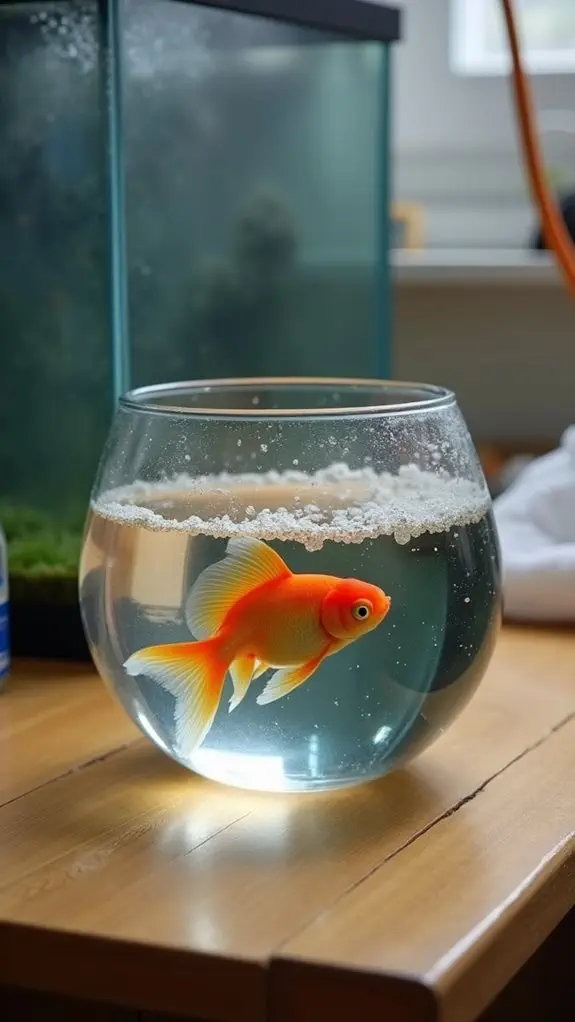
Managing stress levels is essential when transferring fish during tank maintenance. You'll want to minimize any disruptions to your fish's normal behavior while keeping their environment stable.
In fact, if your substrate isn't too shallow or smelly, you can leave your fish in their original tank during cleaning, which is the best stress reduction technique.
If you do need to move your fish, make sure you're using their original tank water in the temporary container. Don't keep them in a holding bowl for more than 30 minutes without an aerator, and always use a lid – fish can be quite the escape artists when they're stressed!
You'll also want to maintain consistent water temperature throughout the process, as sudden changes can shock your finned friends. Ensuring the water quality is optimal helps promote fish health and reduces stress during relocation.
When adding fresh water, stick to changing only 25-50% at a time, and don't forget to use a water conditioner to neutralize harmful chemicals.
Keep movements slow and gentle, avoid loud noises, and provide hiding spots in the temporary container. Think of it like moving to a new house – you'd want the shift to be as smooth as possible, right?
Temperature and Environment Control
When transferring fish to a temporary bowl, maintaining precise temperature control becomes critically important. Your fish are sensitive to sudden changes, and temperature stability is vital for their well-being during tank cleaning.
You'll want to guarantee the water in the temporary bowl matches your tank's temperature exactly, usually between 76° and 80°F.
To create the ideal temporary environment for your finned friends, follow these essential steps:
- Fill the bowl with water from your existing tank, not straight from the tap.
- Place the bowl away from drafts and direct sunlight.
- Use a small heater designed for bowls if cleaning will take more than 30 minutes.
- Monitor the temperature regularly with a reliable thermometer.
Remember that smaller bodies of water lose heat much faster than your main tank, so you'll need to pay extra attention to temperature fluctuations. Additionally, maintaining optimal temperature ranges is crucial to avoid stress during the transfer process.
If you're using a heater, proper heater placement is essential – keep it away from the sides of the bowl and make sure it's fully submerged.
You can also float the bowl in your sink filled with tank-temperature water to help maintain consistent warmth during the cleaning process.
Common Mistakes to Avoid

You'll want to be extra careful about using containers that might've traces of soap or other cleaning products when temporarily housing your fish, as even tiny amounts can be harmful to their delicate systems. It's also important not to make a habit of moving your fish between containers too frequently, since this can cause unnecessary stress and weaken their immune systems over time. Additionally, ensure that the new container has optimal oxygen levels, as low oxygen can lead to hypoxia and potential mortality among fish.
Using Unclean Temporary Containers
Before placing your fish in a temporary container during tank cleaning, ensuring the container's cleanliness is absolutely critical. Many fish owners don't realize that even trace amounts of cleaning products can harm their aquatic friends.
You'll want to avoid any containers that have been washed with soap, detergents, or harsh chemicals, as these residues can be toxic to your fish.
When preparing a temporary container, follow these essential safety steps:
- Rinse the container thoroughly with distilled water multiple times
- Check for any lingering chemical smells that might indicate residue
- Inspect the container for scratches that could harbor harmful bacteria
- Test the container by filling it with water and checking for any unusual cloudiness. Additionally, ensure that the temporary container maintains optimal pH levels, as fluctuations in pH can cause stress to your fish.
Moving Fish Too Frequently
The constant shuffling of fish between tanks and bowls creates unnecessary stress that can severely impact their health. When you move your fish too frequently, you're disrupting their natural fish behavior and potentially compromising their immune system, making them more vulnerable to diseases.
Think of it like this: if someone made you change homes every few days, you'd probably feel pretty stressed too! That's why tank compatibility is essential when you need to temporarily relocate your fish. Instead of using any available container, you'll want to guarantee your temporary setup matches their regular environment as closely as possible. This includes maintaining consistent water temperature, quality, and providing adequate hiding spots.
To minimize stress during necessary moves, like tank cleaning, always prepare your temporary container in advance. Use a proper-sized tank with filtration rather than a small bowl, and include some familiar decorations or plants. Additionally, ensure that the temporary water closely resembles optimal conditions for your fish, including monitoring pH levels to avoid stress.
Alternative Tank Cleaning Strategies
Several effective alternatives exist for cleaning your aquarium without disrupting your fish's environment.
You'll be happy to know that eco-friendly cleaning methods can keep your tank sparkling while ensuring your finned friends stay stress-free.
Consider these fish-safe products and techniques that'll make maintenance a breeze:
- White vinegar for tackling stubborn limescale and water stains
- Specialized algae scrapers that won't scratch your tank's surfaces
- Gravel vacuums that remove debris while keeping water chemistry stable
- Filter media cleaners designed specifically for aquarium use
You can maintain a healthy environment by using a water siphon to vacuum the gravel while performing regular water changes.
This method removes waste and uneaten food without moving your fish to temporary housing.
When cleaning decorations, simply rinse them in tank water rather than tap water to preserve beneficial bacteria.
For routine maintenance, stick to changing 10-25% of the water every other week, and clean your filter media in tank water to keep those good bacteria thriving.
Additionally, it's crucial to monitor ammonia levels during the cleaning process to ensure the well-being of your aquatic friends.
Frequently Asked Questions
Can I Use a Plastic Storage Container Instead of a Bowl?
You can use a plastic storage container as a temporary housing option. It's actually better than a bowl since it provides more space and stability. Just make certain it's clean and chemical-free before using it.
How Many Fish Can I Safely Put in One Temporary Container?
For temporary fish housing, you'll want to keep one fish per container as a general rule. If you need multiple containers, it's safer than risking overcrowding and stress in a single temporary space.
Should I Feed My Fish While They're in the Temporary Container?
Don't feed your fish while they're in temporary containers. Following proper fish feeding guidelines, it's best to skip meals during short stays to prevent water pollution and reduce stress in confined spaces.
Can I Reuse the Same Temporary Container for Future Tank Cleanings?
Yes, you can reuse temporary containers if you maintain proper hygiene. Just clean them thoroughly with a vinegar solution, rinse well with conditioned water, and let them dry completely between uses for safe reuse practices.
What Signs Indicate My Fish Isn't Tolerating the Temporary Container Well?
Watch for rapid breathing, erratic swimming, and clamped fins – these show fish stress. If your fish gasps at the surface or changes color, it's struggling with water quality in the container.
Final Thoughts
You'll find that transferring your fish during tank cleaning isn't as intimidating as it seems when you follow these guidelines. Remember to match water temperatures, use a proper container (not a bowl), and work efficiently to minimize stress on your aquatic friends. With practice, you'll develop a smooth routine that keeps your fish healthy and your tank sparkling clean. Just think of it as giving your fish a quick spa day while you tidy up their home!


